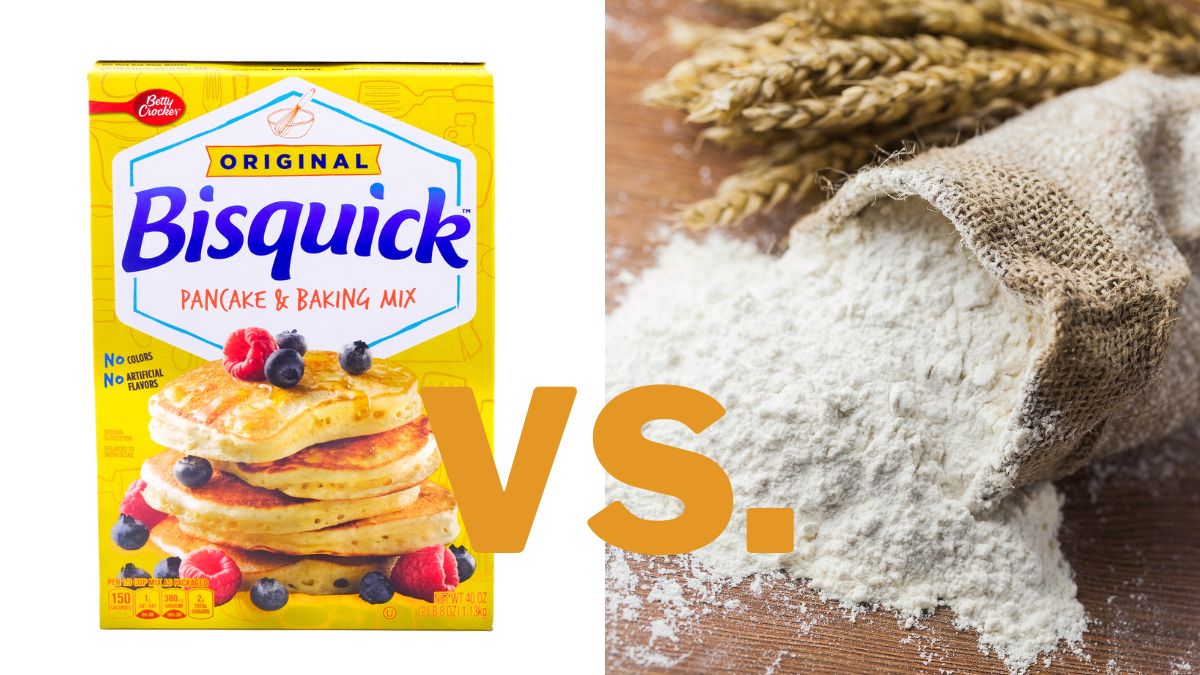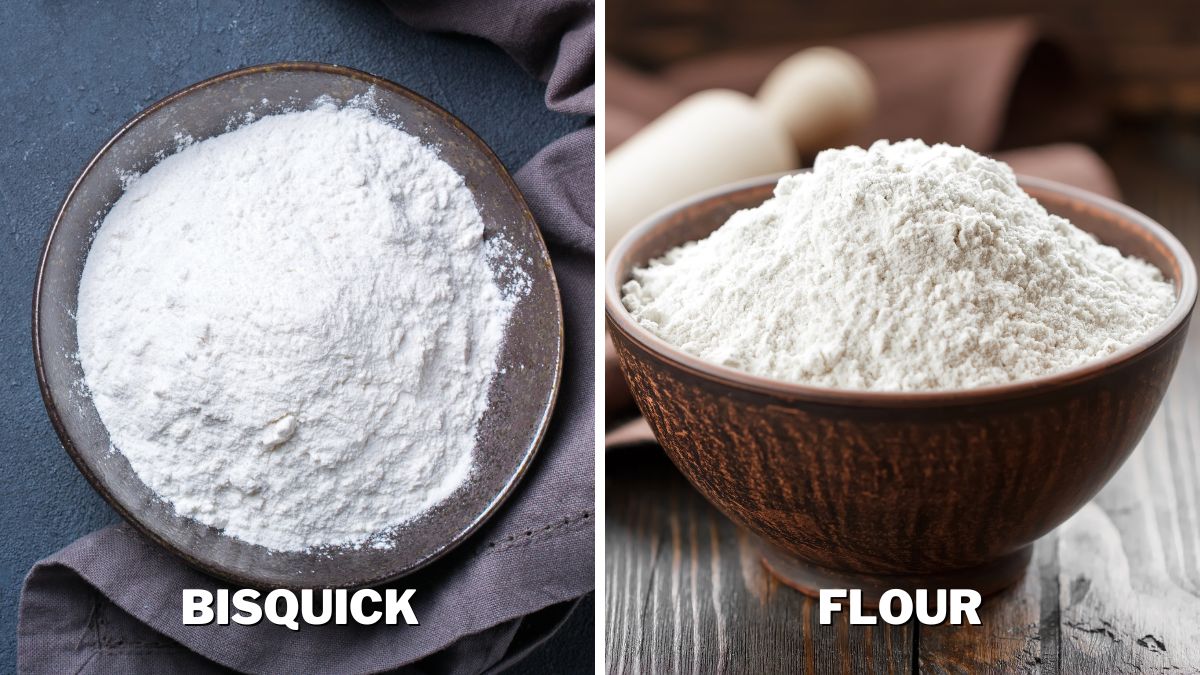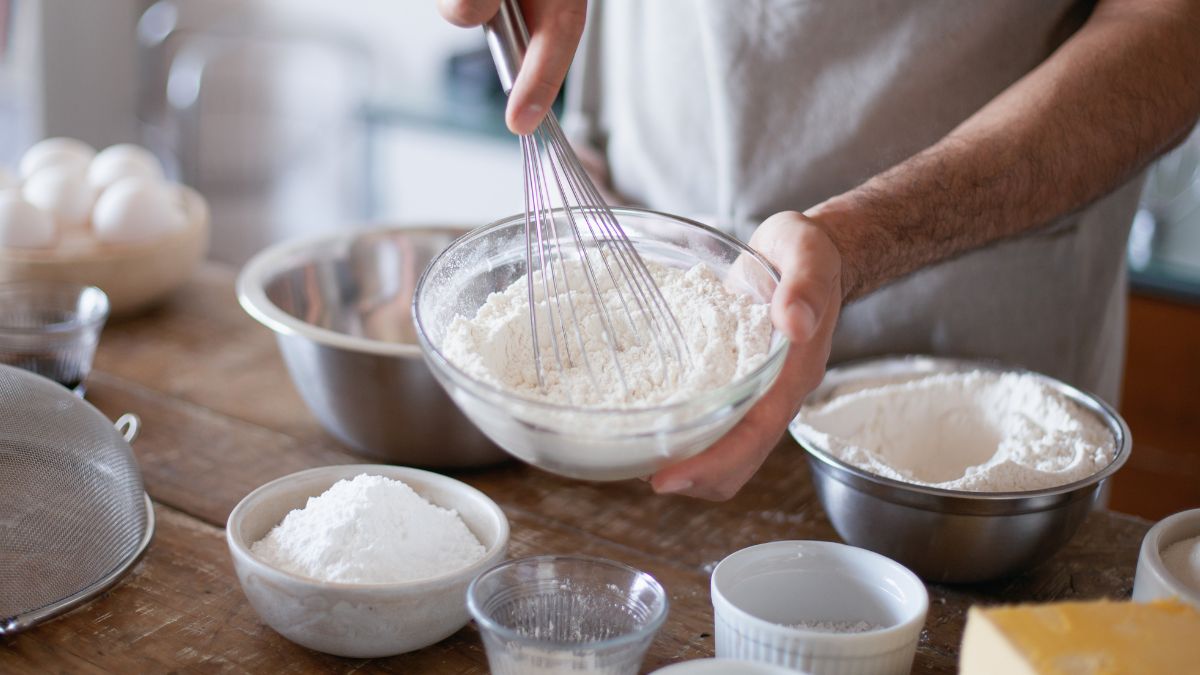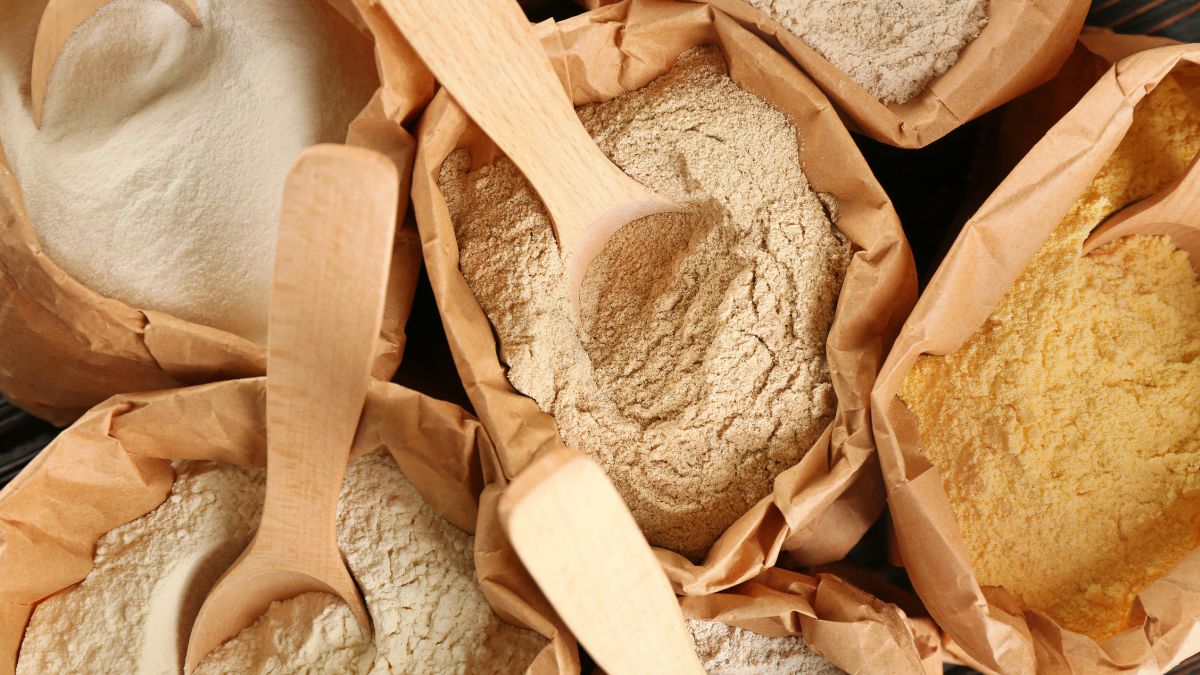Bisquick vs. Flour: Differences & Uses

As a sucker for making and eating baked goods, Bisquick and flour are my kitchen BFFs. Considering that both ingredients are excellent for turning a kitchen into a bakery, you might think that they are actually the same. Bisquick and flour, although serving a similar purpose, aren’t the same thing, and I consider that knowing their differences is crucial for a delicious pastry or any baked good. So, what are the differences between Bisquick and flour?
While flour is a single ingredient, Bisquick is a mixture of flour, baking powder, salt, and sometimes fat. They both produce great results, but Bisquick is more convenient for new bakers who could use some help. While flour takes more skill to turn into a tasty baked good, Bisquick is easier to work with.
Whether you are experienced in the baking department or you are a newbie who is just getting into the realm of baking, you could definitely use some knowledge regarding the ingredients you want to use. These two, specifically, are very frequently used for baking and have sparked many discussions in my culinary circles. To clear the air about these two, in this article, I will share the differences and similarities between them.
Key Differences Between Bisquick and Flour
Although they serve the same purpose, i.e., making baked goods, Bisquick and flour are different ingredients and behave differently when you handle them. In my experience, Bisquick is the one that is easier to work with since it already contains the correct amount of everything.
So, it spares me the trouble of measuring everything to the gram and worrying whether or not my dough will rise and bake properly. Flour, on the other hand, is for the better-skilled baking enthusiasts since it is a single ingredient, and you must measure, adjust, time, and do all the procedures involved in baking.
Below, I give you the differences between these two ingredients, so take a look and see what best suits your time and skills.
Production and Composition

The biggest difference between Bisquick and flour is in their making processes and composition. All crucial differences between them stem from this fact.
Bisquick is a pre-mixed baking mix containing flour, baking powder, salt, and usually hydrogenated oil. The mixture is made to perfection, with all ingredients being precisely measured and adjusted. So, no matter how much you use, the ingredients will always be in perfect proportion.
I find Bisquick very helpful when I am in a rush or just don’t feel like going the whole nine yards for a breadstick. It is very easy to work with; in fact, it is designed to be a convenient option for making quick baked goods without the need to measure individual dry ingredients.
Flour, on the other hand, is a single ingredient and a more complicated one to handle. The making process of flour is as old as time, and it involves grinding grains into fine powder. Depending on the grains, there are many types of flour serving specific purposes.
You must mix flour with additional ingredients to create dough as a single ingredient. Flour is an ingredient made by grinding grains, typically wheat, into a fine powder. It comes in various types, such as all-purpose, whole wheat, and cake flour, each with distinct characteristics resulting from milling and processing.
When using flour, you have to add leavening agents, baking powder, and fat, depending on what you plan to make. The biggest problem for many is getting the exact proportions perfectly so that the resulting dough is of good quality. If you are a beginner, I suggest you start building your baking experience with Bisquick and leave the flour for later.
Properties and Reactions
As I already mentioned, Bisquick is easier to work with because it contains leavening agents like baking powder, resulting in rising baked goods during cooking. It often includes fat for a tender texture. Since it is a pre-made product, you can easily make pancakes and other desserts with minimal effort.
Still, only because it is easier to handle doesn’t mean that Bisquick makes better-tasting baked goods. If you know your way around baking, you will do wonders with flour, too.
Conversely, flour doesn’t contain any leavening agents, which means more work for you. Each baked good recipe includes precise measurements you need to observe to get the desired results.
I sometimes play it by ear, and I don’t always follow the recipe to the letter, which sometimes results in great taste and texture, but sometimes it’s a complete failure. It’s a gamble, but if you feel ready, you can try adding ingredients using your best judgment to avoid all the measuring and precision.
Uses in Cooking: Baking Potential of Bisquick vs. Flour

Bisquick is best known for its use in pancakes, waffles, and cookies. With it, you can easily make airy, fluffy, and light baked goods. Still, even though it is mainly used for light cooking, it doesn’t mean that you can’t give it a chance in more complex baking.
I’ve used it in pies and cakes, as well as a part of savory dishes that call for flour. It is a time-saving option for busy mornings, last-minute gatherings, or spur-of-the-moment cravings for something sweet.
There’s probably no need to tell you what you can use flour for. It has existed since forever and has countless applications. Flour also has many variations; you can make many different meals depending on which kind you use.
You can make everything from plain bread to cakes to pancakes, waffles, croissants, and pies; apply different kneading, rolling, and cooking techniques, and fry, bake, boil, or steam.
Flour offers many options for different skill levels, but you still must have some experience before you get really good unless you are naturally talented, in which case, kudos to you!
Taste and Texture
If we discuss the taste and texture of Bisquick and flour before you turn them into baked goods, both are bland and flavorless. Still, since Bisquick is a mixture, it has a certain baked-good vibe even before you mix it with other ingredients.
If we discuss them in the context of the baked goods they make, there is no single flavor, and the final taste depends on what you add. As a generalization, Bisquick is more or less standardized, and it makes fluffy and light baked goods with a smooth texture and airy consistency.
If you do a good job with flour, it can produce smooth and light baked goods, as well as heavier ones if the recipe calls for ingredients of that sort. The resulting flavor of food made with flour is highly variable and depends on what you add.
The flavor of flour products is very dependent on the skill level of the person making them. They can turn out very delicious if you know how to work with flour dough or plain terrible if you aren’t properly skilled.
There is a learning curve, and you are bound to a few failed attempts, but don’t get disappointed. I’ve had more ruined dough than I would like to admit.
Varieties and Customization Potential

Bisquick is generally consistent in its composition but has a fat-free variety. It isn’t as prone to variation as regular flour, so you can always count on it to deliver the flavor you want.
Flour has many variations, such as wheat, whole-purpose, wholegrain, multigrain, corn flour, etc. It is far more variable than Bisquick because it can come from many different grains.
Can You Use Bisquick Instead of Flour?
Yes, you can use Bisquick as a substitute for flour in specific recipes, but not all of them. Bisquick contains additional ingredients like baking powder, salt, and sometimes fat, which can impact the texture, taste, and leavening of your recipe, so consider the ingredients in the recipe and see if they match those in Bisquick.
For recipes that require flour as a base ingredient without specific leavening requirements, such as thickening sauces or breading items, you can use Bisquick as a replacement in almost all instances.
However, if your recipe involves precise measurements and ratios of flour, leavening agents, and other ingredients, substituting Bisquick might not be the best idea.
You can use the same amount of Bisquick as the amount of flour you would use. Still, out of caution, I always use a quarter less Bisquick than flour and adjust the amount as I go.
I avoid using Bisquick for recipes that call for flour and use it only where I am absolutely certain that it won’t diminish the quality of the baked goods.
Can You Use Flour Instead of Bisquick?
As long as you add the ingredients included in Bisquick, you can absolutely use flour instead. Flour is more versatile than Bisquick, and while you can use Bisquick instead of flour in certain recipes, you can use flour instead of Bisquick in all recipes calling for Bisquick.
I go with all-purpose flour as a Bisquick substitute, and I add a little bit less than the Bisquick amount required in the recipe. Flour is somewhat denser than Bisquick, so thread lightly and don’t add too much all at once.
Do you use Bisquick or flour more often? I would love to hear about your kitchen practices in the comments below!
